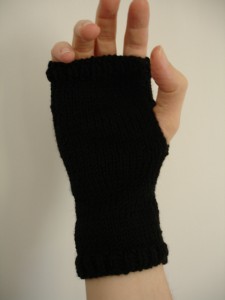#4 – A good ribbing
 Mitten swatch agreed by all. That intangible Yamamoto weight to the stitch is achieved. Time to measure wrist, calculate numbers of stitches, and consider depth of ribbing.
Mitten swatch agreed by all. That intangible Yamamoto weight to the stitch is achieved. Time to measure wrist, calculate numbers of stitches, and consider depth of ribbing.
Ribbing is like a good picture frame. Not only does it contain, hold in place, pull into shape, but it balances the whole. It sets a tone. You can either go traditional or contemporary with ribbing. There’s a fine line. Length and breadth are neither here nor there. The ribbing informs what you have chosen to do with the body of the garment, and vice versa.
Imagine da Vinci’s Mona Lisa surrounded by her Renaissance golden curlicues framing that sly smile. Now imagine her with a plain, patent black frame. What different stories that would tell. You get the picture.
I settle for a narrow ribbing, equal length, at both ends of the mitten. Needles crossed it works out. That’s part of the fun of knitting your own recipes. Worst case scenario, and I can always undo.
I am undone by too short a length to the mitten. But with a little help from the obsessive knitter, who picks up my lost stitches, all is saved. And I get a good ribbing.
BDW
